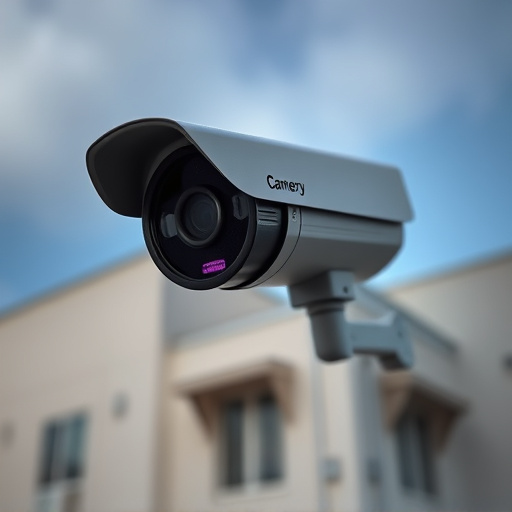Optimizing the placement of a Fake Dome Bullet Camera is crucial for enhancing security, with a recommended mounting height of 10-15 feet offering strategic views. Consider environmental factors and targets, aiming for clear sights of high-traffic areas like entranceways and parking lots. Secure brackets maintain stability against weather while preserving discretion. Balancing location needs, environmental factors, and camera capabilities ensures optimal viewing angles; testing and adjustments are vital as environments change. Mounting heights should be 5-10 feet above ground, with strategic alignment covering entry points and outdoor spaces. Avoid critical mistakes like incorrect heights or placement near windows/reflective surfaces for effective security measures.
“Enhance your home or business security with our comprehensive guide on Fake Dome Bullet Camera placement. Understanding the optimal mounting height for these cameras is key to effective surveillance. We’ll walk you through essential factors like camera type, environmental conditions, and legal requirements. Learn best practices for positioning your fake security cameras strategically, and avoid common pitfalls that could undermine their effectiveness. Maximize the potential of your Fake Dome Bullet Camera placement today.”
- Understanding Fake Dome Bullet Camera Types and Their Placement Needs
- Factors to Consider When Choosing the Optimal Mounting Height
- Best Practices for Effective Fake Security Camera Placement
- Common Mistakes to Avoid During Fake Camera Mounting and How to Rectify Them
Understanding Fake Dome Bullet Camera Types and Their Placement Needs
Fake Dome Bullet cameras are a popular choice for home and business security systems due to their sleek design and wide field of view. Understanding the optimal placement for these cameras is crucial for maximizing their effectiveness. These cameras typically have a fixed mounting height, usually between 10-15 feet (3-4.5 meters) above ground level, offering a strategic vantage point for surveillance.
When installing a Fake Dome Bullet Camera, consider the environment and targets of interest. For outdoor applications, placing the camera at this recommended height ensures clear, unobstructed views of entranceways, parking areas, and other high-traffic zones. The mounting should be secure and stable, often achieved with sturdy brackets or mounts designed for weather resistance. This placement allows for optimal detection and deterrence while providing a discreet presence, blending seamlessly into the environment.
Factors to Consider When Choosing the Optimal Mounting Height
When determining the optimal mounting height for a fake dome bullet camera, several factors come into play. Firstly, consider the specific requirements of your location and environment. Different settings demand varied observation angles; for instance, a bustling city street may necessitate a higher placement to capture clear footage above traffic and buildings, whereas a quiet residential area could benefit from a lower angle to monitor activity around homes or businesses.
Additionally, the type of camera and its intended use should guide your decision. Fake dome bullet cameras offer versatile coverage but their field of view varies; some models excel at wide-angle surveillance while others provide more focused observation. Mounting height can enhance these capabilities—a higher placement may be ideal for broader area monitoring, whereas a lower angle could better suit detailed examination of specific zones.
Best Practices for Effective Fake Security Camera Placement
When placing a fake security camera, such as a dome or bullet model, consider both aesthetic and practical factors for optimal results. Positioning should be strategic to deter potential intruders while maintaining an unobtrusive appearance. Typically, mounting heights range from 5 to 10 feet (1.5 to 3 meters) above the ground, ensuring a clear view of entry points like doors, windows, or perimeter fences.
Aligning the camera’s field of view with high-risk areas is crucial for effective surveillance. For front entrances and common areas, point the lens slightly downward to capture faces and activities without appearing overly vigilant. In outdoor settings, aim for a 120-degree horizontal view to cover broader spaces, like walkways or parking lots. Regularly testing and adjusting camera positioning will help maintain their effectiveness as environments and threats evolve.
Common Mistakes to Avoid During Fake Camera Mounting and How to Rectify Them
Many individuals setting up fake security cameras make a few crucial mistakes that can compromise their intended effect. One common error is mounting the camera at an incorrect height, often too low or too high relative to the area being monitored. This can lead to poor visual coverage and reduced deterrence value. To avoid this, ensure the camera is positioned at eye level or slightly elevated—a standard recommendation for both real and fake security systems.
Additionally, improper placement of fake dome bullet cameras is another frequent blunder. These cameras are designed to mimic real surveillance equipment, so their positioning should be strategic. Avoid placing them too close to windows or other reflective surfaces that could distort the image or reveal the setup’s artificiality. Spacing them apart and angling them appropriately can help maintain realism and enhance overall security measures.
In conclusion, optimal placement of a Fake Dome Bullet Camera is crucial for effective security monitoring. By understanding camera types, considering key factors like field of view and lighting conditions, and adhering to best practices, you can maximize the deterrence value of your fake cameras. Avoid common mistakes such as incorrect height adjustment or poor visibility, and ensure your security system remains a reliable deterrent for potential intruders.
